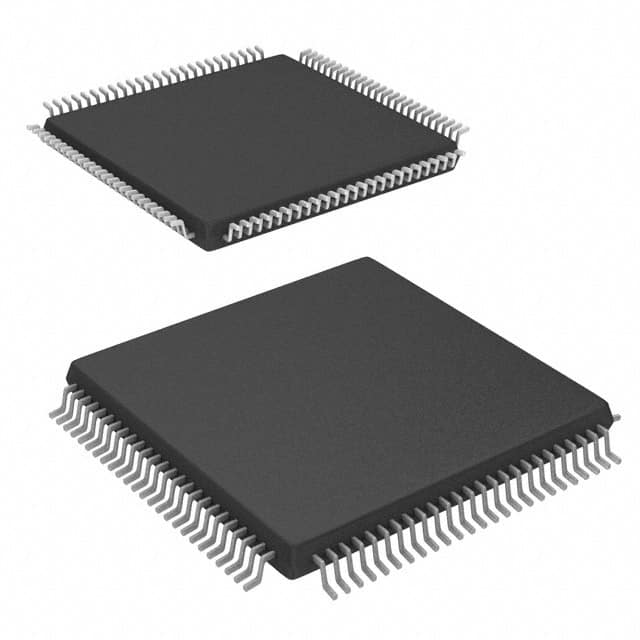Voir les spécifications pour les détails du produit.

EPM570T100C3N - English Editing Encyclopedia Entry
Product Overview
- Category: Programmable Logic Device (PLD)
- Use: Digital logic design and implementation
- Characteristics: High-performance, reprogrammable, integrated circuit
- Package: TQFP (Thin Quad Flat Pack)
- Essence: Configurable logic blocks and programmable interconnects
- Packaging/Quantity: Available in tubes or reels, quantity varies based on order size
Specifications
- Manufacturer: Intel Corporation
- Family: MAX II
- Device Type: CPLD (Complex Programmable Logic Device)
- Number of Macrocells: 570
- Operating Voltage: 3.3V
- Speed Grade: C3
- Temperature Range: -40°C to +85°C
- Package Type: 100-pin TQFP
Detailed Pin Configuration
The EPM570T100C3N has a total of 100 pins. The pin configuration is as follows:
- VCCIO0
- GND
- IO_0
- IO_1
- IO_2
- IO_3
- IO_4
- IO_5
- IO_6
- IO_7
- IO_8
- IO_9
- IO_10
- IO_11
- IO_12
- IO_13
- IO_14
- IO_15
- IO_16
- IO_17
- IO_18
- IO_19
- IO_20
- IO_21
- IO_22
- IO_23
- IO_24
- IO_25
- IO_26
- IO_27
- IO_28
- IO_29
- IO_30
- IO_31
- IO_32
- IO_33
- IO_34
- IO_35
- IO_36
- IO_37
- IO_38
- IO_39
- IO_40
- IO_41
- IO_42
- IO_43
- IO_44
- IO_45
- IO_46
- IO_47
- IO_48
- IO_49
- IO_50
- IO_51
- IO_52
- IO_53
- IO_54
- IO_55
- IO_56
- IO_57
- IO_58
- IO_59
- IO_60
- IO_61
- IO_62
- IO_63
- IO_64
- IO_65
- IO_66
- IO_67
- IO_68
- IO_69
- IO_70
- IO_71
- IO_72
- IO_73
- IO_74
- IO_75
- IO_76
- IO_77
- IO_78
- IO_79
- IO_80
- IO_81
- IO_82
- IO_83
- IO_84
- IO_85
- IO_86
- IO_87
- IO_88
- IO_89
- IO_90
- IO_91
- IO_92
- IO_93
- IO_94
- IO_95
- GND
- VCCIO1
Functional Features
- High-density programmable logic device with 570 macrocells
- Flexible and reprogrammable architecture for rapid prototyping and design iterations
- Supports various I/O standards and interfaces
- On-chip memory blocks for data storage and processing
- Efficient power management features for low-power applications
- Built-in security features to protect intellectual property
Advantages and Disadvantages
Advantages: - Versatile and flexible for a wide range of digital logic designs - Reprogrammable nature allows for iterative development and testing - High-density integration reduces board space requirements - Support for multiple I/O standards enables easy interfacing with other devices - Power management features optimize energy consumption
Disadvantages: - Limited number of macrocells compared to higher-end PLDs - Complexity of programming and design flow may require specialized knowledge - Higher cost
Énumérez 10 questions et réponses courantes liées à l'application de EPM570T100C3N dans les solutions techniques
Sure! Here are 10 common questions and answers related to the application of EPM570T100C3N in technical solutions:
Q: What is EPM570T100C3N? A: EPM570T100C3N is a specific model of Field-Programmable Gate Array (FPGA) manufactured by Intel.
Q: What are the key features of EPM570T100C3N? A: EPM570T100C3N offers 570,000 logic elements, 33,216 embedded memory bits, and 1,288 embedded multipliers.
Q: How can EPM570T100C3N be used in technical solutions? A: EPM570T100C3N can be used for various applications such as digital signal processing, image and video processing, and high-performance computing.
Q: What programming languages are supported by EPM570T100C3N? A: EPM570T100C3N supports programming in VHDL (Very High-Speed Integrated Circuit Hardware Description Language) and Verilog HDL (Hardware Description Language).
Q: Can EPM570T100C3N be reprogrammed after deployment? A: Yes, EPM570T100C3N is a field-programmable device, which means it can be reprogrammed even after it has been deployed in a system.
Q: What tools are available for programming EPM570T100C3N? A: Intel Quartus Prime is the software tool provided by Intel for designing, simulating, and programming EPM570T100C3N.
Q: What are the power requirements for EPM570T100C3N? A: EPM570T100C3N typically operates at a voltage of 1.2V and requires a power supply capable of delivering sufficient current for the application.
Q: Can EPM570T100C3N interface with other components or devices? A: Yes, EPM570T100C3N supports various communication protocols such as I2C, SPI, UART, and Ethernet, allowing it to interface with other components or devices.
Q: Are there any limitations or considerations when using EPM570T100C3N? A: Some considerations include power consumption, heat dissipation, and the need for proper cooling mechanisms due to the high-performance nature of the device.
Q: Where can I find additional resources or support for EPM570T100C3N? A: Intel provides documentation, datasheets, reference designs, and an online community forum where users can find additional resources and support for EPM570T100C3N.

